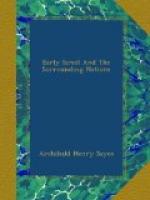They had been settled in the strip of pasture-land which borders the Freshwater Canal of to-day, and is still a place of resort for the Bedawin from the east. It lay apart from the cultivated lands of the Egyptian peasantry, it adjoined the desert which led to Asia, and it was near the Hyksos capital of Zoan. Meneptah, the son and successor of Ramses II., tells us that from of old it had been given by the Pharaohs to the nomad shepherds of Asia; and after the departure of the Israelitish tribes the same king is informed in a letter from one of his officials that the deserted district had been again handed over to Bedawin from Edom. This was in the eighth year of the king’s reign, three years later than that in which the Exodus must have taken place.
For 400 years the Israelites had been “afflicted” by the Egyptians. But while the Eighteenth dynasty was in power their lot could not have been hard. They still remained the free herdsmen of the Pharaoh, feeding their flocks and cattle on the royal demesne. During the reign of Khu-n-Aten, indeed, their own Semitic kinsmen from Canaan held the chief offices of state, and the Pharaoh was endeavouring to force upon his subjects a form of monotheism which had much in common with that of Israel. The language of the hymns engraved on the walls of the tombs at Tel el-Amarna reads not unfrequently like the verses of a Hebrew Psalm.
The national reaction which found its expression in the rise of the Eighteenth dynasty swept away the power and influence of Asia, and brought back the gods and religion of Egypt. The Semites who had absorbed the government of the country were expelled or slain; their weaker brethren, the Israelites in Goshen, were enslaved. Egypt became for them a house of bondage, and they had to toil under the lash of the taskmaster at the cities and temples which the Pharaoh built. Ramses held his court at Zoan, like the Hyksos of old days, but it was to keep guard over the Asiatic frontier, not to be in touch with a kindred people in Canaan. Canaan itself was conquered afresh, and the Canaanitish captives—the “mixed multitude” of the Bible—assisted the Israelites in erecting the monuments of their conqueror.
Nevertheless, the people multiplied. The memory of the Hyksos invasion had not passed away, and the Pharaoh and his subjects alike feared the possibility of other invaders from Asia being joined by their disaffected kinsfolk in Egypt itself. That their fears were justified is shown by what happened less than a century later. When the Nineteenth dynasty fell in the midst of civil war, a Canaanite, Arisu by name, seized the throne and made himself master of Egypt. Ramses determined to prevent such a catastrophe by destroying as many as possible of the male children of the Hebrews. The men were worn down in body and mind by constant labour, the children were not allowed to live.
Egyptian testimony confirms the statement of Scripture that this policy was actually carried out. A hymn of victory addressed to Meneptah alludes to “the Israelites” to whom “no seed” had been left. But the policy was ineffectual. The opportunity came at last when the serfs could fly from their enforced labour and escape into the wilderness.




